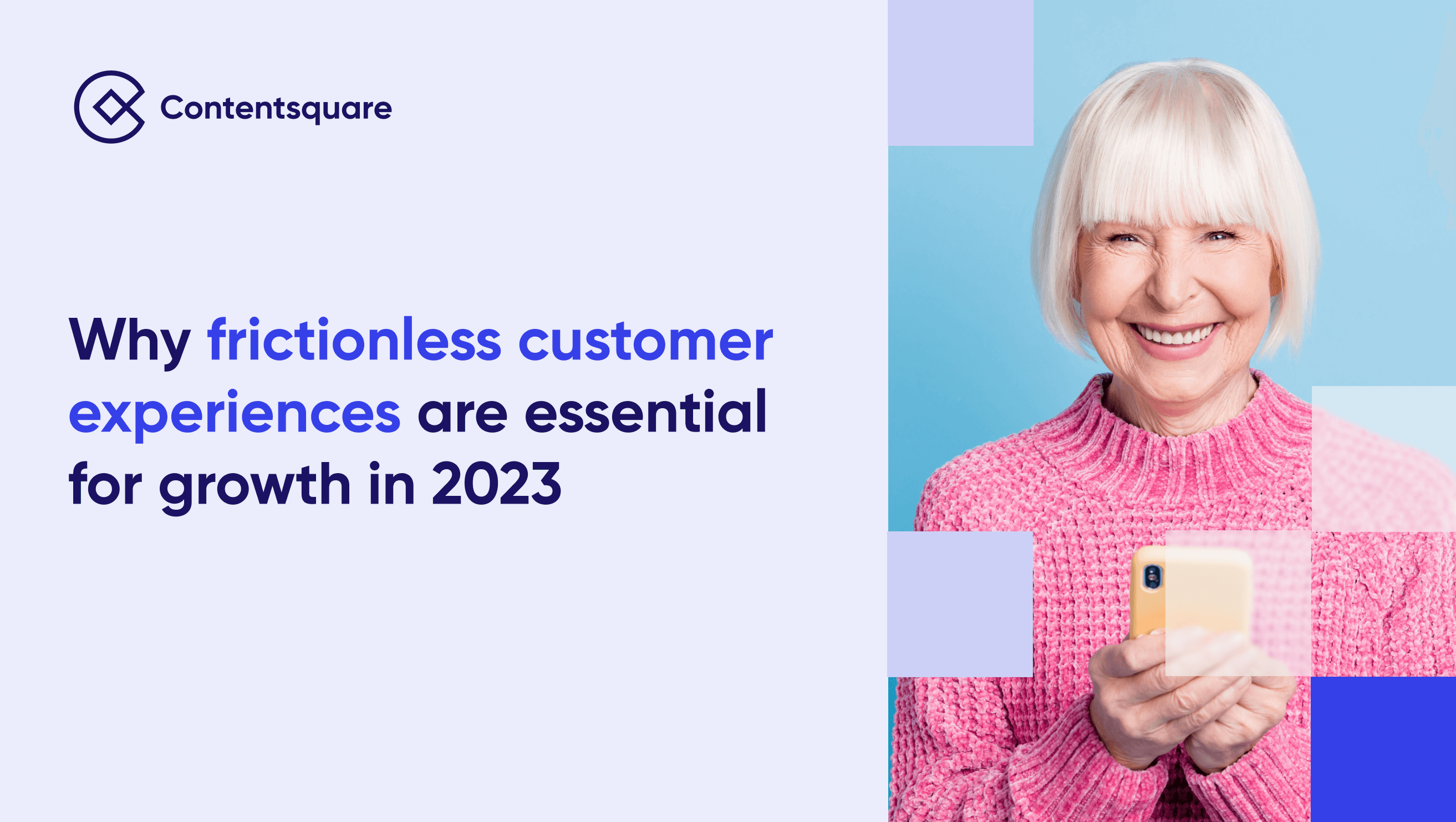
Uncover trends for crucial digital KPIs
Access the 2024 Digital Experience Benchmarks Report and Interactive Explorer.

To persuade consumers to part with their hard-earned cash at this time of economic uncertainty, you need a standout digital service—and one surefire way to immediately stand out from the crowd is to provide website and app visitors with a truly frictionless customer experience.
That’s because frustration-free experiences are still far from the norm—and customer frustration is commonplace. We analyzed over 35 billion user sessions in 2022 for our 2023 Digital Experience Benchmark Report; frustration negatively impacted more than 1 in 3 (36%, to be precise) of those sessions.
User frustration undoubtedly contributed to some other discouraging 2022 trends revealed in our report, such as a 2% rise in bounce rate and a 3.1% drop in conversion rate.

Uncover trends for crucial digital KPIs
Access the 2024 Digital Experience Benchmarks Report and Interactive Explorer.
Driving growth through your digital customer experience in 2023 will be as much about removing customer friction points from your journeys as adding value to them.
You’ll need to eradicate technical bugs and improve your user experience through better design and copywriting. And—as we’ll explain in part two of this two-part blog—you’ll need digital experience analytics to do it.
This is part one. In it, we’ll talk about why user frustration is a bigger problem now than ever before and investigate what the key frustration factors are, including technical errors and user experience issues.
In part two, we’ll discuss why digital experience analytics holds the key to fixing customer friction and driving growth—and how top brands use Contentsquare products, including CS Find & Fix, to eliminate friction from their journeys.
‘Friction’ doesn’t sound that serious—like something that temporarily slows something else down. But actually, it can be (and increasingly is) a session killer.
If users can’t quickly find a workaround to the customer friction point you’ve unwittingly dropped into their path to purchase, they’ll get frustrated fast.
At this point, they may contact your support team. More likely, they’ll opt to leave your website and run straight into the waiting arms of your competitors. They may feel sufficiently chagrined to make a point of telling their social circle to avoid your website like the plague.
In 2023, customer expectations around digital experiences are sky-high and rising. There’s an ever-growing multitude of websites vying for their attention and business. And with the economy already providing consumers with ample ‘IRL’ friction and frustration, they won’t tolerate much more of it from your website.
The bottom line? Frustration in your digital journeys is going to lose you business this year. Unless, that is, you take action. Step one is to understand its causes.
The best-laid plans of digital teams can go awry in all sorts of ways. (You can learn which frustration factors were most common and damaging to digital customer experiences in 2022 by reading our 2022 Digital Experience Benchmark Report.)

Uncover trends for crucial digital KPIs
Access the 2024 Digital Experience Benchmarks Report and Interactive Explorer.
For brevity, we’ll place the numerous causes of user frustration under two categorical umbrellas:
Backend bugs, including Javascript and API errors, cause numerous headaches for website users: Buttons won’t work; Payments fail; Entire pages crash. They’re repeatedly hailed with mildly (or, if cheerily written, extremely) infuriating error messages.
Technical obstacles block the user’s path to conversion and undermine their sense of your brand’s credibility. After all, if you can’t provide a relatively seamless, smooth experience, how good can your products and services be?
Clearly, it’s bad when web pages don’t work. But it’s also bad when web pages do work—but not fast enough. With attention spans dwindling and options for consumers multiplying, you’d be crazy to overlook the frustration that comes with sub-par web performance.
Today’s spoilt-for-choice consumers won’t be inclined to wait around for web pages to load. In fact, most will only be willing to wait for about two seconds.

That’s right: Our Benchmark Report reveals that sites with load times over two seconds have a 49% bounce rate. There’s no clearer illustration of how damaging even a few seconds of frustration can be to your digital customer experience.
Designing a website to be user-friendly is rarely a wholly designer-friendly process. Digital teams are tasked with always keeping the customer’s perspective in mind, which can be highly challenging. What’s obvious to a web designer or copywriter is oftentimes not at all obvious to a user.
And so, inevitably, there’ll be times when—to your surprise—users feel confused, overwhelmed and (yup) frustrated by a page that makes perfect sense to you.
It might be a placement-related problem. Users can’t work out where to scroll or click next to advance. You’ve inadvertently placed crucial information in a place most users aren’t seeing, potentially giving users unrealistic expectations that you’re doomed to disappoint.
Or it could be a language-related problem. A button’s been labeled vaguely, so users don’t know what happens when they click on it, or misleadingly, so users are disappointed by what happens when they have clicked on it.
Knowing the causes of user frustration is all well and good—but actually detecting and fixing customer friction points in practice is another thing entirely.
There are certainly best practices to follow. For example, we share some tips for removing friction in our blog three tips for creating a positive digital experience for your users.
But websites are highly complex and constantly evolving beasts, and the causes of friction can change on a daily, if not hourly, basis. Plus, detecting friction is only half the battle; even if you know that something’s impeding your user journeys, it won’t always be immediately obvious what that something is.
Digital teams certainly have their work cut out for them to successfully detect and get to the bottom of frustration and friction. And it’s not as if they’re lacking other things to be getting on with.
But help is at hand—in the form of digital experience analytics (DXA).
DXA tracks the behavior of visitors to your website, including what happens ‘between the clicks’, and enables digital teams to dig deeper into the data and discover what’s driving that behavior.
In part two of our blog, we’ll explain why DXA is key to delivering the frictionless customer experience that will drive growth this year.
We’ll also provide some examples of how Contentsquare DXA platform features (such as our recently added Frustration Score) are helping businesses remove friction and reap the rewards in higher conversion rates and revenue.
In the meantime, check out our 2023 Digital Experience Benchmark Report for more insights into user frustration and everything else that matters in the digital customer journey.

Uncover trends for crucial digital KPIs
Access the 2024 Digital Experience Benchmarks Report and Interactive Explorer.

